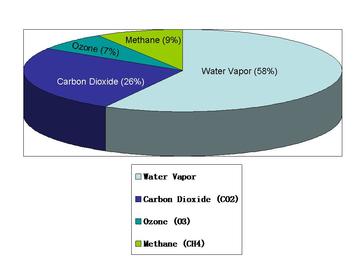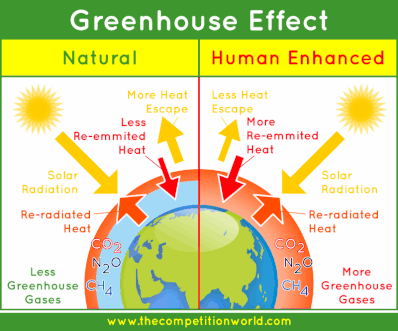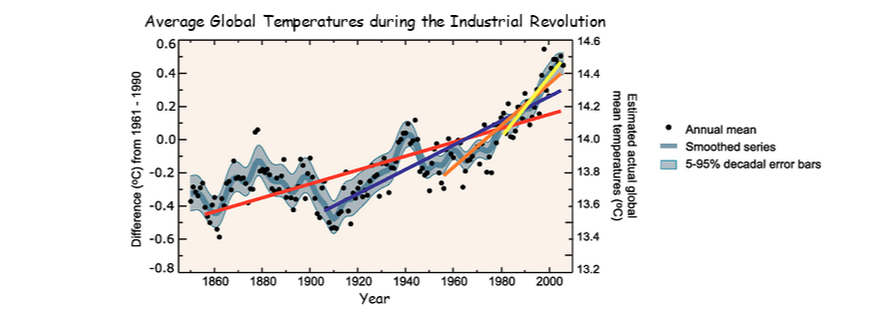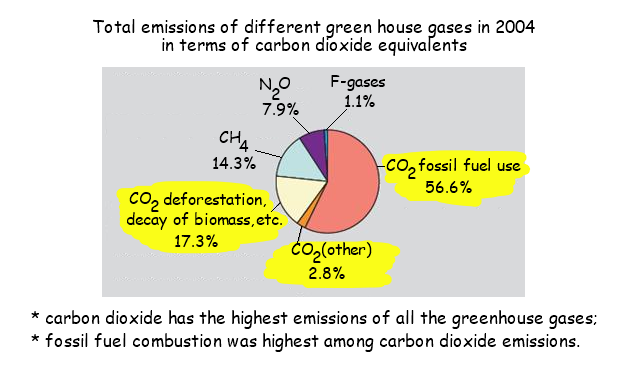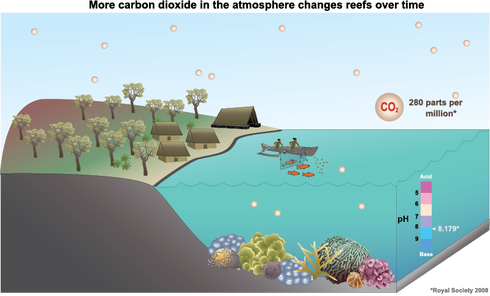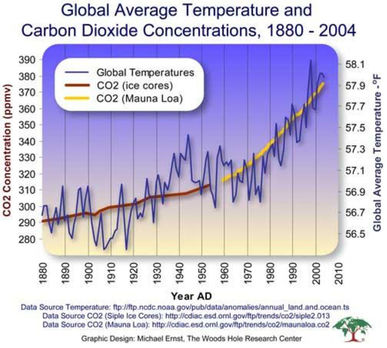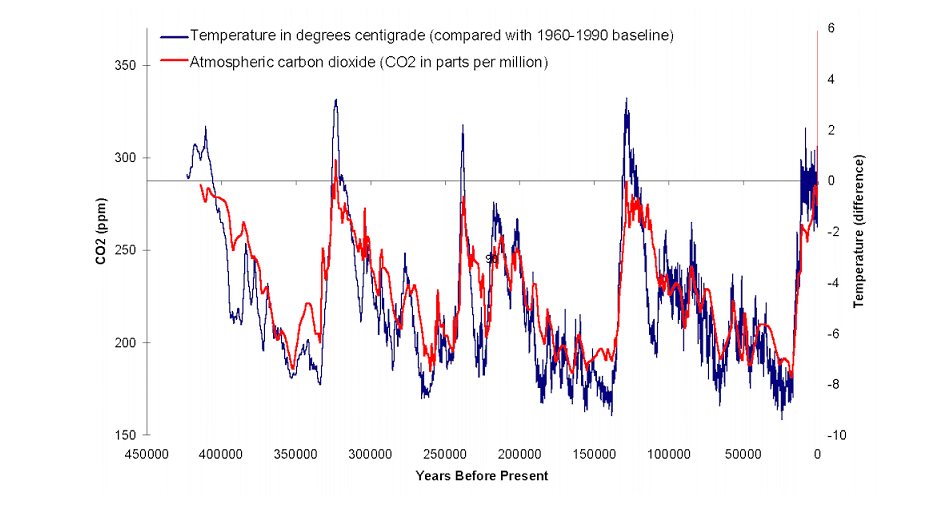4.4 climate change

In the Climate Change unit, we take a look at how certain gases, the most important of which are carbon dioxide and water vapour, enable the atmosphere to retain heat. Without these gases in the atmosphere, the Earth's temperature would be too low to support life. We will also look at how the warming effect of these gases known as the greenhouse effect caused in a similar way to the warming of a greenhouse.
This unit will last 3 school days
This unit will last 3 school days
Essential idea:
- Concentrations of gases in the atmosphere affect climates experienced at the Earth’s surface.
Nature of science:
- Assessing claims—assessment of the claims that human activities are producing climate change. (5.2)
- Outline ways by which claims can be evaluated for truth.
- Outline ways by which claims can be evaluated for truth.
Understanding
4.4.U 1 Carbon dioxide and water vapour are the most significant greenhouse gases.
- State the sources of CO2 and water vapor in the atmosphere.
- Outline the mechanism by which greenhouse gases trap heat in the atmosphere.
Greenhouse gases absorb and emit long-wave (infrared) radiation, thereby trapping and holding heat within the atmosphere
- Greenhouse gases collectively make up less than 1% of the Earth’s atmosphere
- Water vapour is created via evaporation of water bodies (e.g. oceans) and transpiration – it is removed via precipitation (rain)
- Carbon dioxide is made by cell respiration and burning fossil fuels – it is removed via photosynthesis and absorption by oceans
U 4.4.U2 Other gases including methane and nitrogen oxides have less impact.
- State the sources of methane and NO gases in the atmosphere.
Methane has the third greatest impact on the greenhouse effect. It is emitted from marches, other water-logged habitats and from landfill sites containing organic wastes.
Nitrous oxide, which is another significant greenhouse gas is released naturally by bacteria in some habitats and also by agriculture and vehicle exhaust.
All the greenhouse gases together make up less than 1% of the earth’s atmosphere
Nitrous oxide, which is another significant greenhouse gas is released naturally by bacteria in some habitats and also by agriculture and vehicle exhaust.
All the greenhouse gases together make up less than 1% of the earth’s atmosphere
4.4.U3 The impact of a gas depends on its ability to absorb long wave radiation as well as on its concentration in the atmosphere.
- State two factors that determine the warming impact of a greenhouse gas.
- State two variables that determine the concentration of a gas in the atmosphere.
- Compare the impact of atmospheric methane to CO2.
- State how long water, methane and CO2 remain in the atmosphere, on average.
The two factors that determine how much of an influence a gas will have on the greenhouse effect are
Methane actually has the ability to cause much more warming per molecule than carbon dioxide; however, there is a much lower concentration of methane in the atmosphere
- The ability of the gas to absorb long-wave radiation (heat)
- The concentration of the gas in the atmosphere
Methane actually has the ability to cause much more warming per molecule than carbon dioxide; however, there is a much lower concentration of methane in the atmosphere
Each greenhouse gas (GHG) has different effects on warming the Earth. It will depend on the GHG's ability to absorb enerty, and how long it remains in the atmosphere.
Global Warming Potential (GWP) is been developed to make comparisons of the global warming impacts of different GHGs.
Global Warming Potential (GWP) is been developed to make comparisons of the global warming impacts of different GHGs.
Larger the GWP means the more that a given gas warms the Earth compared to CO2
GWPs provide a common unit of measure allowing for the adding up emissions estimates of different gasses
GWPs provide a common unit of measure allowing for the adding up emissions estimates of different gasses
4.4.U4 The warmed Earth emits longer wavelength radiation (heat).
- State that the Earth absorbs short-wave energy from the sun and re-emits longer wavelengths.
- Compare wavelengths of UV, visible and infrared radiation.
When light (shorter wavelengths) enters the earth’s atmosphere, some of the light reflects off the earth’s surface back towards outer space.
Some of the light is converted into heat, which in turn warms the surface of the earth (the air, mountains and water). This heat (longer wavelengths) radiates off the earth back towards the atmosphere. The peak wavelength for infrared is 10,000 nm, while the peak wavelength of solar radiation is 400 nm
Some of the light is converted into heat, which in turn warms the surface of the earth (the air, mountains and water). This heat (longer wavelengths) radiates off the earth back towards the atmosphere. The peak wavelength for infrared is 10,000 nm, while the peak wavelength of solar radiation is 400 nm
4.4.U5 Longer wave radiation is absorbed by greenhouse gases that retain the heat in the atmosphere
- Explain the greenhouse effect, with reference to short wave radiation from the sun, long wave radiation from the Earth and the effects of ozone and greenhouse gases.
- Explain why water vapor, CO2, methane and NO are greenhouse gases.
Greenhouse gases such CO2 and water vapor absorb this heat (infrared radiation) trapping it within the atmosphere, further warming the earth.
70-75% of the solar radiation reaches the earth’s surface, with a high percentage of this radiation being converted into heat
As the infrared radiation is reflected back off the earth, a large percentage of this heat is captured by the greenhouse gases in the atmosphere. This energy is re-emitted, thus heating up the earth’s atmosphere. This effect is called global warming.
The ability of the earth’s surface to reflect light is called the albedo effect. Light colored and white objects such as snow and ice, have a high albedo and therefore little light is absorbed and less heat is produced. Black and dark colored objects like asphalt and pavement have a low albedo, and therefore absorb more light and produce more heat.
With the spread of urban cities and areas, a greater amount of heat is being produced
70-75% of the solar radiation reaches the earth’s surface, with a high percentage of this radiation being converted into heat
As the infrared radiation is reflected back off the earth, a large percentage of this heat is captured by the greenhouse gases in the atmosphere. This energy is re-emitted, thus heating up the earth’s atmosphere. This effect is called global warming.
The ability of the earth’s surface to reflect light is called the albedo effect. Light colored and white objects such as snow and ice, have a high albedo and therefore little light is absorbed and less heat is produced. Black and dark colored objects like asphalt and pavement have a low albedo, and therefore absorb more light and produce more heat.
With the spread of urban cities and areas, a greater amount of heat is being produced
4.4.U6 Global temperatures and climate patterns are influenced by concentrations of greenhouse gases.
- Explain why atmospheric CO2 concentration would logically impact global temperatures.
- Outline the effect of global temperature on climate, specifically location and frequency of of rain and frequency of severe storms.
Climate refers to the patterns of temperature and precipitation that occur over long periods of time. Climate changes over thousands or millions of years. Climatologists and palaeoclimatologists collect and study data about atmospheric conditions in recent decades and from the distant past in order to infer what the climate was like thousands to millions of years ago.
Since greenhouse gases cause the earth to retain heat, one can infer that the more greenhouse gas there is in the atmosphere, the warmer the earth will be. This does not mean that the amount of greenhouse gas is the only reason for the earth warming and cooling; however, there is a correlation between the earth’s temperature and the amount of greenhouse gas. Other factors such as the cycles in the Earth’s orbit around the sun, variations in the amount of solar radiation due to sunspot activity, past volcanic activity, and changes or oscillations in ocean currents
Even if greenhouse gases aren’t the only factor in the rise of the Earth’s temperature, if the Earth heats up even a few degrees, it will have profound effects on the climate patterns
Since greenhouse gases cause the earth to retain heat, one can infer that the more greenhouse gas there is in the atmosphere, the warmer the earth will be. This does not mean that the amount of greenhouse gas is the only reason for the earth warming and cooling; however, there is a correlation between the earth’s temperature and the amount of greenhouse gas. Other factors such as the cycles in the Earth’s orbit around the sun, variations in the amount of solar radiation due to sunspot activity, past volcanic activity, and changes or oscillations in ocean currents
Even if greenhouse gases aren’t the only factor in the rise of the Earth’s temperature, if the Earth heats up even a few degrees, it will have profound effects on the climate patterns
How will projected greenhouse gas concentrations affect temperatures?
Key Global Temperature Projections
(IPCC 2013: http//www.ipcc.ch/report/or5/wg1/
(IPCC 2013: http//www.ipcc.ch/report/or5/wg1/
- Increases in average global temperatures projected within range of -17.5 degree C to -13 degree C by 2010 with likely increase to be at least -16.3
- Global average temperature is expected to be at least twice as wram in the next 100 years as it has during the last 100 years
- Ground-level air temperatures are expected to warm more rapidly over land than oceans
- Larger temperature increases projected to be greater than the global average in some parts of the world.
How will projected greenhouse gas concentrations affect climate patterns?
Key Global Temperature Projections
(IPCC 2013: http//www.ipcc.ch/report/or5/wg1/
(IPCC 2013: http//www.ipcc.ch/report/or5/wg1/
- Global average annual precipitation expected to increase to end of century, however, changes the amount and intensity of precipitation will vary significantly by region
- On average, an increase in the intensity of precipitation events, more pronounced in tropical and high-latitude regions
- Increase in wind strenghts and amount of precipitation associated with tropical storms
- Projected annual average precipitation to increase in some areas and decrease in others
4.4.U7 There is a correlation between rising atmospheric concentrations of carbon dioxide since the start of the industrial revolution 200 years ago and average global temperatures
- State the atmospheric CO2 concentration prior to the industrial revolution.
- Outline the impact of the industrial revolution on atmospheric CO2 concentration.
- Describe the correlation between atmospheric CO2 concentrations since the industrial revolution and global temperatures.
Graph (IPCC 2007 report) above shows that the global mean temperature has increased since the start of the Industrial Revolution
Graph also shows the rate of temperature increase (the steepness of the slope: red, blue, orange, becomes larger as more of the world became industrialized
Graph also shows the rate of temperature increase (the steepness of the slope: red, blue, orange, becomes larger as more of the world became industrialized
4.4.U8 Recent increases in atmospheric carbon dioxide are largely due to increases in the combustion of fossilized organic matter.
- Explain why industrial revolution would increase atmospheric CO2 concentrations.
As described above, since the industrial revolution the amount of CO2 has drastically increased, largely due to the increasing quantities of combustion of fossilized organic matter (coal, oil and natural gas). The number one source of carbon emissions due to human activities is through combustion of fossil fuels in automobiles, buses and planes.
Another source of carbon dioxide is the deforestation through burning large tracks of land and heating homes with fossil fuels, such as natural gas. Humans demand for meat has led to large numbers of cattle, which is responsible for releasing methane into the atmosphere, which is changed into carbon dioxide. As the human population increases and countries become more industrialized, human production of greenhouse gas, shows no sign of slowing down
Another source of carbon dioxide is the deforestation through burning large tracks of land and heating homes with fossil fuels, such as natural gas. Humans demand for meat has led to large numbers of cattle, which is responsible for releasing methane into the atmosphere, which is changed into carbon dioxide. As the human population increases and countries become more industrialized, human production of greenhouse gas, shows no sign of slowing down
Application
4.4.S1 Threats to coral reefs from increasing concentrations of dissolved carbon dioxide.
- Explain how historical temperature data has been collected.
- Using ice core data, outline the correlation between atmospheric CO2 concentration and global temperatures.
Ocean acidification is the ongoing decrease in the pH of the Earth's oceans, caused by the uptake of carbon dioxide from the earth’s atmosphere. Over 500 billion tons of CO2 released by humans since the start of the industrial revolution have been dissolved in the oceans. pH of surface layers of the earth’s oceans in the late 18th century ≈ 8.1179 currently ≈ 8.069, which represents about a 30% acidification.
Reef-building corals that use calcium carbonate in their exoskeletons need to absorb carbonate ions from seawater.
The concentration of carbonate ions is low in seawater because they are not very soluble. Dissolved CO2 makes the carbonate concentration even lower as a result of some interrelated chemical reactions: CO2 + H2O <--> H2CO3 <--> H+ + HCO3− <--> H+ + CO32 –
If the carbonate ions concentrations drop it is more difficult for reef-building corals to absorb these ions to make their exoskeletons. Also, if seawater ceases to be a saturated solution of carbonate ions, existing calcium carbonate tends to dissolve, so existing exoskeletons of reef-building corals are threatened.
Volcanic vents in the Gulf of Naples have been releasing carbon dioxide into the water for thousands of years, reducing the pH of the seawater. In this area of acidified water there are no corals, sea urchins or other animals that make their exoskeletons from calcium carbonate. In their place other organisms like invasive algae and sea grasses flourish. Unfortunately this could be the disheartening future for coral reefs around the world if carbon dioxide emissions continue to rise… Loss of tropical coral reefs to acidification could cost $1 trillion by 2100 in terms of lost shoreline protection and lost revenues for the tourism and food industries.
Reef-building corals that use calcium carbonate in their exoskeletons need to absorb carbonate ions from seawater.
The concentration of carbonate ions is low in seawater because they are not very soluble. Dissolved CO2 makes the carbonate concentration even lower as a result of some interrelated chemical reactions: CO2 + H2O <--> H2CO3 <--> H+ + HCO3− <--> H+ + CO32 –
If the carbonate ions concentrations drop it is more difficult for reef-building corals to absorb these ions to make their exoskeletons. Also, if seawater ceases to be a saturated solution of carbonate ions, existing calcium carbonate tends to dissolve, so existing exoskeletons of reef-building corals are threatened.
Volcanic vents in the Gulf of Naples have been releasing carbon dioxide into the water for thousands of years, reducing the pH of the seawater. In this area of acidified water there are no corals, sea urchins or other animals that make their exoskeletons from calcium carbonate. In their place other organisms like invasive algae and sea grasses flourish. Unfortunately this could be the disheartening future for coral reefs around the world if carbon dioxide emissions continue to rise… Loss of tropical coral reefs to acidification could cost $1 trillion by 2100 in terms of lost shoreline protection and lost revenues for the tourism and food industries.
4.4.S2 Correlations between global temperatures and carbon dioxide concentrations on Earth.
- Outline three reasons why there is vigorous debate around the claim that human activities are causing climate change.
- Correlation does not imply causation
- Hundreds of years is not enough time to establish the validity of such a relationship
- To establish a causal relationship it must be demonstrated that the presumed cause precedes the presumed effect
- This relationship should be demonstrable over several cycles of increases and decreases in both of the parameters
4.4.S3 Evaluating claims that human activities are not causing climate change
- Outline the effect of atmospheric CO2 concentration on ocean pH.
- Describe the impact of lower ocean pH on animals that make skeletons from calcium carbonate.
Do you see any evidence in graph that humans are not causing climate change?
Argument human activities not causing climate change
- Three glacial terminations and four glacial inceptions over the last half million years
- Noted that increases and decreases in atmospheric CO2 concentration not only did not precede the changes in air temperature, CO2 concentrations followed air temperatures
- CO2 levels followed temperatures by hundreds of years later
- Also noted times when CO2 level dropped and air temperature remained unchanged or actually rose
- Hence, the past half-million years provides absolutely no evidence ongoing rise in the CO2 levels will lead to significant global warming/climate change.
Key Terms
|
greenhouse gas
atmosphere coral reefs |
nitrogen oxide
carbon dioxide global temperature climatologist |
water vapor
carbon cycle industrial revolution |
radiation
Anthropogenic factors Precautionary principle |
heat
nitric acid methane |
Classroom Material
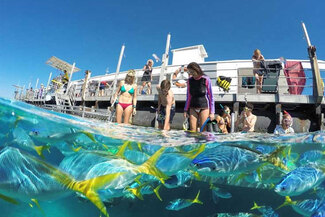
STARTER and DISCUSSION
This interactive multimedia resource by the Guardian can be used as a starter of discussion prompt on the effect of carbon pollution upon a reef ecosystem (4.4.A1 Threats to coral reefs from increasing concentrations of dissolved carbon dioxide)
This interactive multimedia resource by the Guardian can be used as a starter of discussion prompt on the effect of carbon pollution upon a reef ecosystem (4.4.A1 Threats to coral reefs from increasing concentrations of dissolved carbon dioxide)
PowerPoint and Study Guide on Topic 4.4 by Chris Payne
Your browser does not support viewing this document. Click here to download the document.
Your browser does not support viewing this document. Click here to download the document.
Correct use of terminology is a key skill in Biology. It is essential to use key terms correctly when communicating your understanding, particularly in assessments. Use the quizlet flashcards or other tools such as learn, scatter, space race, speller and test to help you master the vocabulary.
Useful Resources
The Natural Greenhouse Effect:
Animated tutorial from Damocles.
Simple tutorial from UCSD and another from the BBC
Earth's Climate: Back to the Future
Climate change and the enhanced greenhouse effect:
Try this PhET Lab simulation: The Greenhouse Effect (allow Java to run)
The NASA Climate Change Resource Reel has loads of video and animation clips which download as .mpg files when you click on them.
Good Climate Change teaching resources from Cutting Edge
The Ultimate Climate Change FAQ from the Guardian
Warming over the last 130 years, by NASA
Precautionary Principle
Find out more from pprinciple.net.
So they key issue is this: we suspect that human activity leads to climate change. We are still collecting data to support (or refute) this hypothesis, and the evidence is growing stronger and stronger that anthropogenic climate destabilisation is true. In the meantime, should we wait for more evidence before taking action or should we take preventative and remedial measures now, in order to get a ‘head start’?
Topic link: how does ocean acidification link to the chemistry of life unit?
Finally, a concise article on Why the Global Warming Skeptics are wrong, from the New York Review of Books.
Nice animated gif from http://www.skepticalscience.com/pics/SkepticsvRealistsv3.gif
The Natural Greenhouse Effect:
Animated tutorial from Damocles.
Simple tutorial from UCSD and another from the BBC
Earth's Climate: Back to the Future
Climate change and the enhanced greenhouse effect:
Try this PhET Lab simulation: The Greenhouse Effect (allow Java to run)
The NASA Climate Change Resource Reel has loads of video and animation clips which download as .mpg files when you click on them.
Good Climate Change teaching resources from Cutting Edge
The Ultimate Climate Change FAQ from the Guardian
Warming over the last 130 years, by NASA
Precautionary Principle
Find out more from pprinciple.net.
So they key issue is this: we suspect that human activity leads to climate change. We are still collecting data to support (or refute) this hypothesis, and the evidence is growing stronger and stronger that anthropogenic climate destabilisation is true. In the meantime, should we wait for more evidence before taking action or should we take preventative and remedial measures now, in order to get a ‘head start’?
Topic link: how does ocean acidification link to the chemistry of life unit?
Finally, a concise article on Why the Global Warming Skeptics are wrong, from the New York Review of Books.
Nice animated gif from http://www.skepticalscience.com/pics/SkepticsvRealistsv3.gif
In The News
Arctic Warming Twice as Fast as Rest of World (2013-08-06)
Fixing Climate Not So Easy (2013-08-12)
Today's Climate Change Proves Much
Faster Than Changes in Past 65 Million Years (2013-08-02)
A Reprieve From Warming, Thanks to the Pacific (2013-08-28)
Northern forests rev up carbon cycle (2013-08-08)
Mounting Consequences as Arctic Sea Ice Melts (2013-08-01)
The polar bear who died of climate change (2013-08-06)
Climate Update: Warming Temperatures (2013-08-09)
Climate Change Leaves Hares Wearing The Wrong Colors (2013-09-08)
Arctic sea-ice minimum is sixth smallest on record (2013-09-18)
Freighter Makes First-Of-Its-Kind Transit Of Northwest Passage (2013-09-27)
How Climate is Changing the Acidity of the Ocean from BBC Science
Arctic Warming Twice as Fast as Rest of World (2013-08-06)
Fixing Climate Not So Easy (2013-08-12)
Today's Climate Change Proves Much
Faster Than Changes in Past 65 Million Years (2013-08-02)
A Reprieve From Warming, Thanks to the Pacific (2013-08-28)
Northern forests rev up carbon cycle (2013-08-08)
Mounting Consequences as Arctic Sea Ice Melts (2013-08-01)
The polar bear who died of climate change (2013-08-06)
Climate Update: Warming Temperatures (2013-08-09)
Climate Change Leaves Hares Wearing The Wrong Colors (2013-09-08)
Arctic sea-ice minimum is sixth smallest on record (2013-09-18)
Freighter Makes First-Of-Its-Kind Transit Of Northwest Passage (2013-09-27)
How Climate is Changing the Acidity of the Ocean from BBC Science
International-mindedness:
- Release of greenhouse gases occurs locally but has a global impact, so international cooperation to reduce emissions is essential
TOK:
- The precautionary principle is meant to guide decision-making in conditions where a lack of certainty exists. Is certainty ever possible in the natural sciences?
Videos:
A musical investigation into the causes and effects of global climate change and our opportunities to use science to offset it. Featuring Bill Nye, David Attenborough, Richard Alley and Isaac Asimov. "Our Biggest Challenge" is the 16th episode of the Symphony of Science series by melodysheep
The most up-t0-date and reliable data-based information can be found on the annual NOAA Arctic Report Card. This quick video from NASA gives an overview:
Threats to the Arctic, from the WWF, and a nice summary of the effects of global warming on the Arctic, from CIEL. the Guardian also has an article on the disappearing world of the last of the arctic hunters.
In this TED Global 2010 talk, Lee Hotz describes the work of researchers in the Antarctic, studying the history of our planet’s climate, through drilling ice-cores that go back in thousands of years.
TED Talk from Rob Dunbar, on the Mission Blue Voyage, about the dangers of ocean acidification and how we are discovering ancient climates in the oceans and ice:
In which Hank details the five scariest things that will likely happen because of climate change.
Here’s a nice explanation of the ‘debate’:
NOAA's Mauna Loa Observatory on the Big Island of Hawaii,is a leading atmospheric research facility. The observatory has been collecting and monitoring data relating to atmospheric change since the 1950s. Dr John Barnes, the Station Chief for the observatory, describes the functions of the MLO, which provides valuable long-term and continuous recording of data.
The Precautionary Principle
We can’t afford to wait any longer to act on climate change
